Christmas Murder Mystery 1926
Christmas Murder Mystery 1926
Status: In Development 🎨 (almost there!)
Development Time: 2+ weeks (14+ hours/day, hyperfocused)
Players: 11 interconnected characters → 10 people signed up
Pages: 100+ game materials
Setting: 1920s Manhattan
Event: December 25, 2025
The Origin Story
It started on a beach.
I was stuck. No prospects. Feeling creatively blocked. Nobody (my personal Cri-Kee 💙) suggested—again—that I try AI.
“But it can’t be creative,” I said.
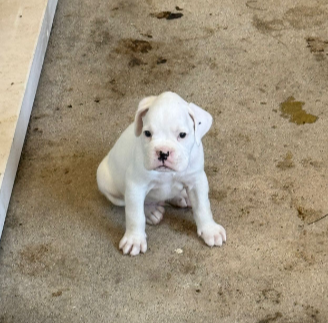
(me innocent as a baby dog)(yodo)
Well. Guess not.
A few weeks earlier, I’d seen an Instagram reel from a creative director who made a murder mystery party for her friends. I loved it. I wanted to make one too.
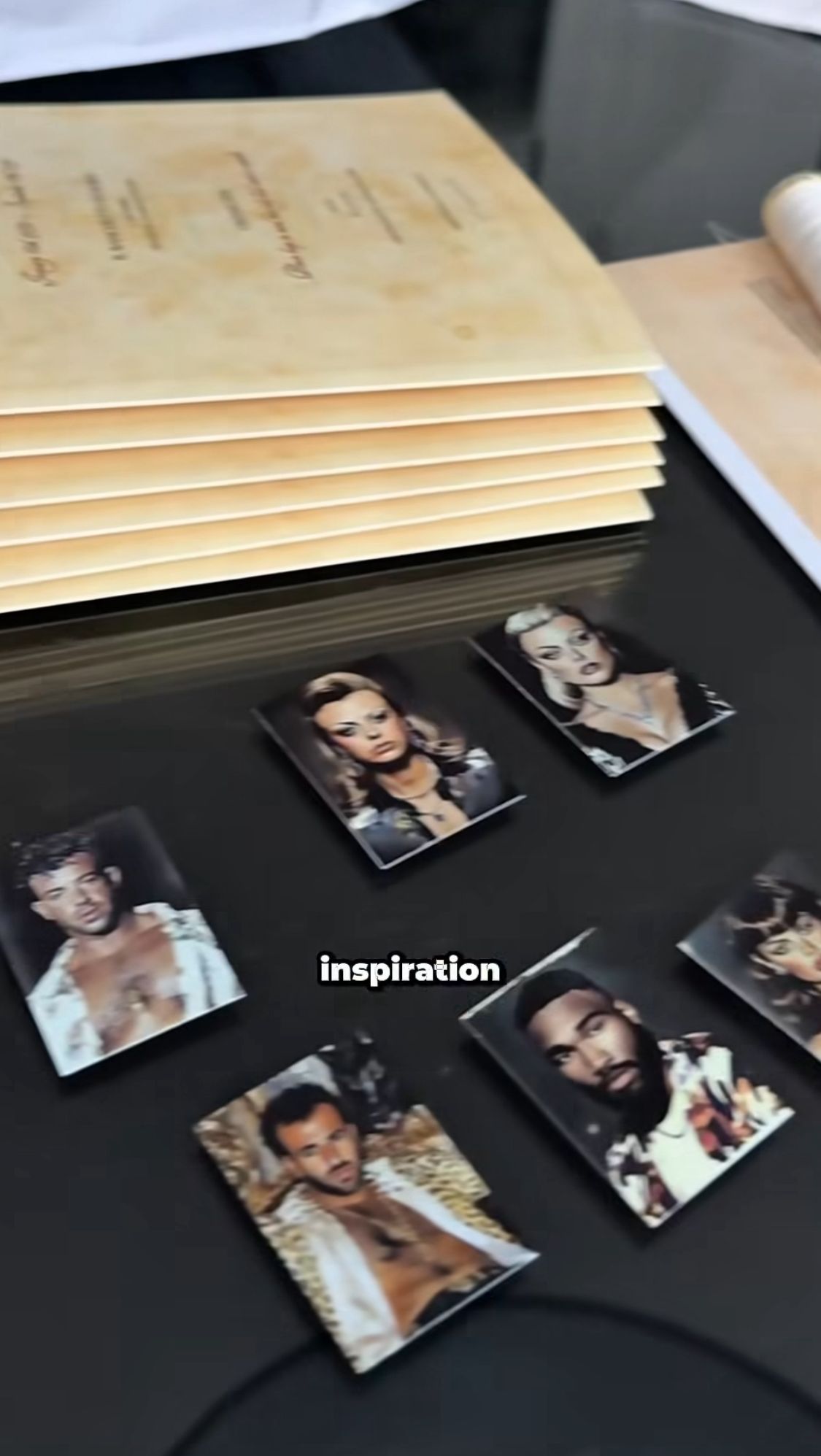
Insta:viktoria.psd
My sister hosts a Christmas dinner every year with friends. I suggested we do a murder mystery this year instead.
10 people signed up.

So I had 2 weeks to make an 11-character murder mystery roleplay game from scratch.
With AI as my production team.
Spoiler: It worked. 🎭
What It Is
A complete murder mystery roleplay game for 11 players set in 1920s Manhattan. Each player receives:
- Detailed character sheet with backstory
- Secret relationships and objectives
- Plot threads that intersect with other characters
- A murder to solve (or commit)
(photo: sample character sheet pages spread out ou stacked game materials)
Total materials: 100+ pages of custom-designed game content
(photo: printed character booklets ou digital files preview)
Development Story
Week 1: Character Development & Story Architecture
Claude became the mastermind behind this project—the creative collaborator that feeds my ideas and helps them evolve.
Character Brainstorming
Discussion about base archetypes and how to create characters that connect organically at a 1926 Christmas party.
Claude suggested: Start with motivations, then build the secret relationships.
Web of Connections
Creating secret relationships between characters. Each needed at least 3 connections with others.
Challenge: Maintain coherence across all backstories without contradictions.
Cross-Analysis
Claude analyzed all 11 backstories simultaneously to identify temporal and logical inconsistencies.
Result: Found 7 conflicts that were resolved before final production.
Hidden Motivations
Each character needed objectives that would create tension and drama during gameplay.
Claude helped: Balance competitive and collaborative objectives to keep everyone engaged.
Refinement
Multiple rounds of feedback and adjustments. Some characters completely changed direction.
Learning: AI as creative collaborator works best with rapid iterations.
Final Documentation
Transform all conversations into structured character sheets for each player.
Format: Backstory + relationships + objectives + secret information.
- Started with character concepts and relationships
- Developed 11 interconnected backstories with secret connections
- Created plot threads that weave between characters
- Multiple iterations to ensure narrative coherence
- Claude analyzed consistency across all character arcs
Character Relationship Web
SPOILER ALERT
(click to reveal)
SPOILER ALERT
(click to reveal)
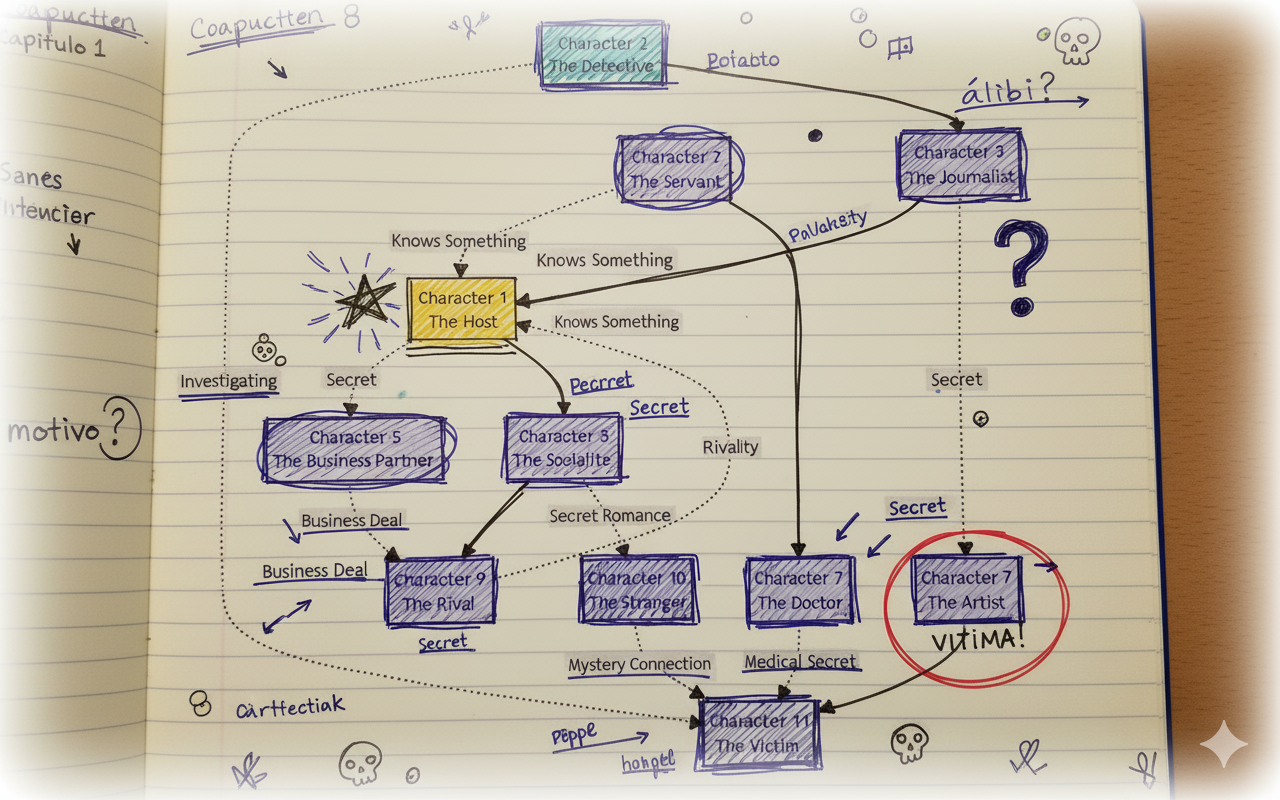
Week 2: Production Pipeline
With characters locked, it was time to build everything.
graph TD
A[Week 2: Production]
A --> B[Typesetting Automation]
A --> C[AI Character Portraits]
A --> D[Video Teaser Production]
A --> E[Git Version Control]
A --> F[Final Assembly]
B & C & D & E --> F
style A fill:#FF6B6B
style B fill:#4ECDC4
style C fill:#4ECDC4
style D fill:#4ECDC4
style E fill:#4ECDC4
style F fill:#95E1D3
- Typesetting automation with Typst
- AI-generated character portraits and assets
- Video teaser production
- Git-based version control for all content
- Final assembly and testing
Tools & Workflow
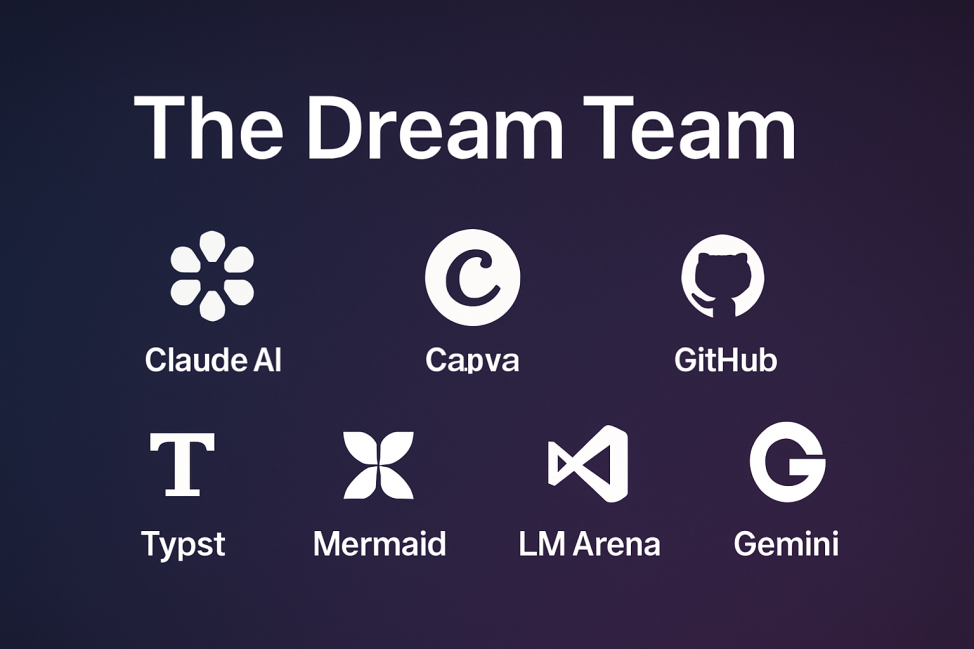
The Mastermind: Claude
Claude was the creative engine behind this entire project. Not just a tool—a collaborator that:
- Helped develop and refine 11 interconnected character arcs
- Analyzed narrative consistency across backstories
- Evolved ideas from vague concepts to concrete plots
- Fed my creativity instead of replacing it
Character Portraits: Gemini
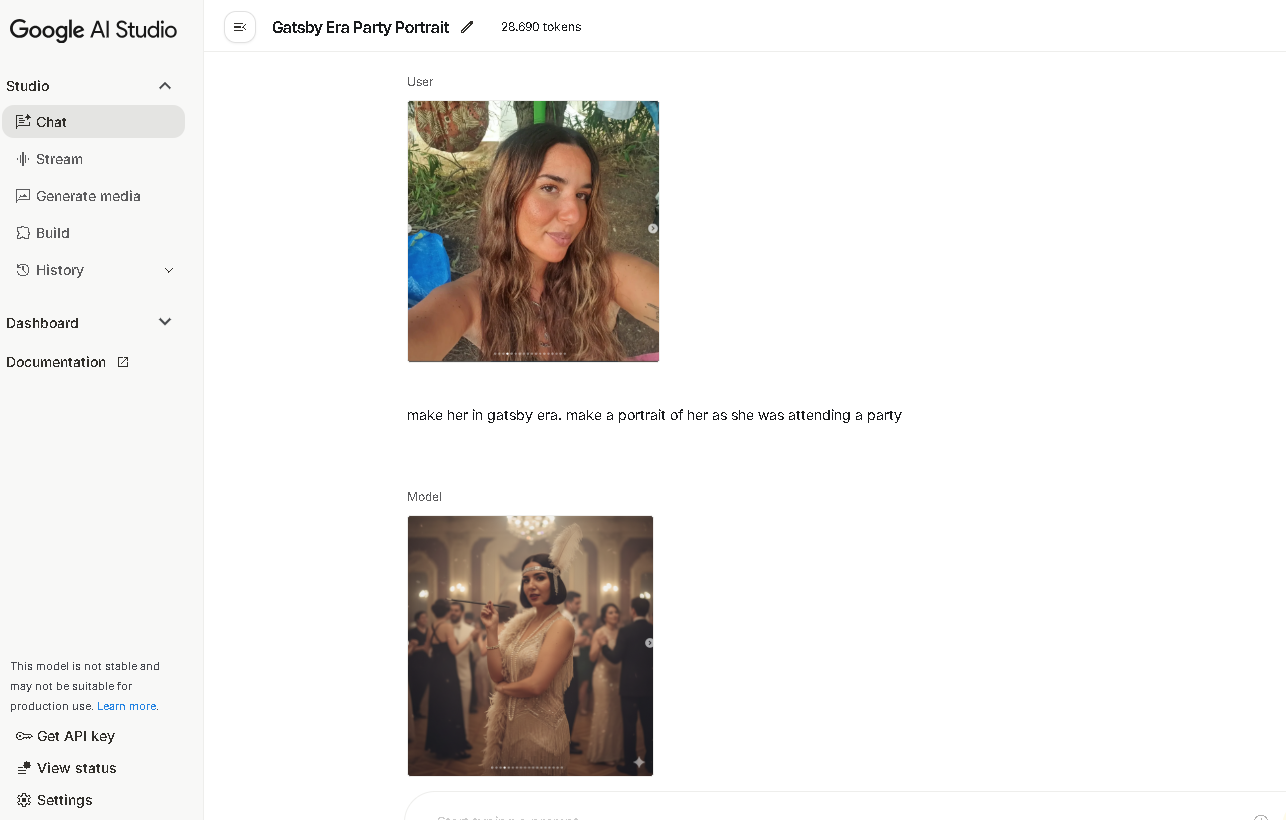
Image Generation:
- Prompt + reference photo → character portraits
- Multiple iterations per character
- Style consistency across all 11 characters
Guest List
GUEST LIST
(click to reveal)
GUEST LIST
(click to reveal)
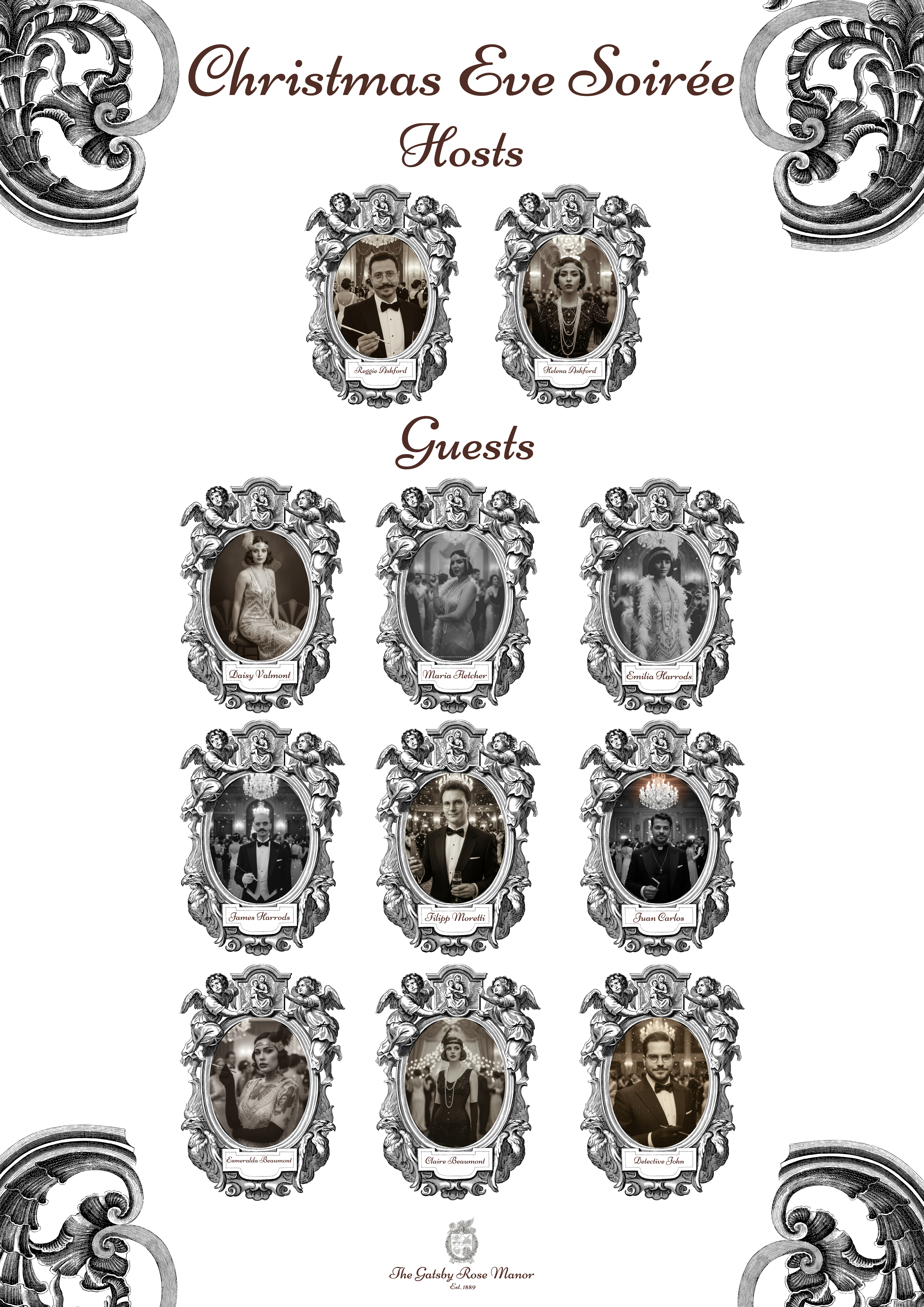
Voice Generation:
- Script-to-voice for audio clips
- Character-specific variations
- Multiple takes for selection
Video Production: The lm-arena Experience
The Discovery:
I had budget on Fal.ai and tried MANY programs, including Sora. Results? Always shit.
Then I tried lm-arena with Sora.
Same tool. Different platform. Quite different. Better.
Why? I don’t know. But lm-arena became my favorite video generation tool.
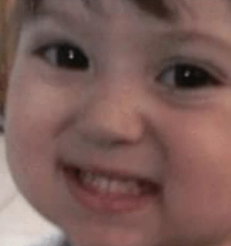
The Process:
- Used multiple accounts (thanks Discord friends!)
- Generated multiple video clips in parallel
- High success rate for parameter-specific outputs
- Created several clips, fell in love with one I didn’t even use
- Final editing in kdenlive
Sound Design:
- SFX created with Adobe Firefly
- Audio clips from Gemini voice generation
- Final mix in kdenlive
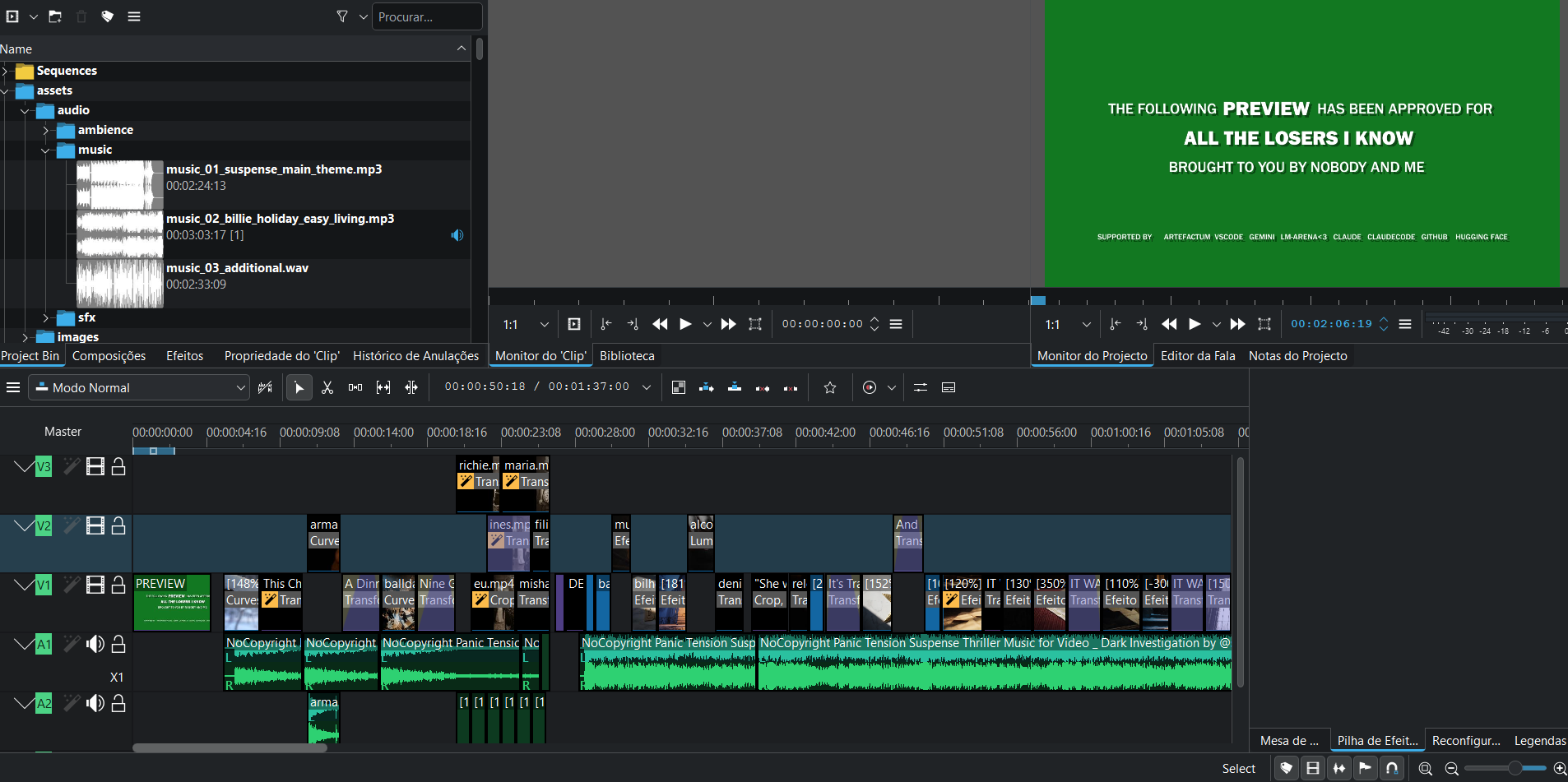
Want the full workflow? Read the complete Video Production Pipeline and Why lm-arena beats Fal.ai posts.
The Development Backbone: Cline (VS Code)
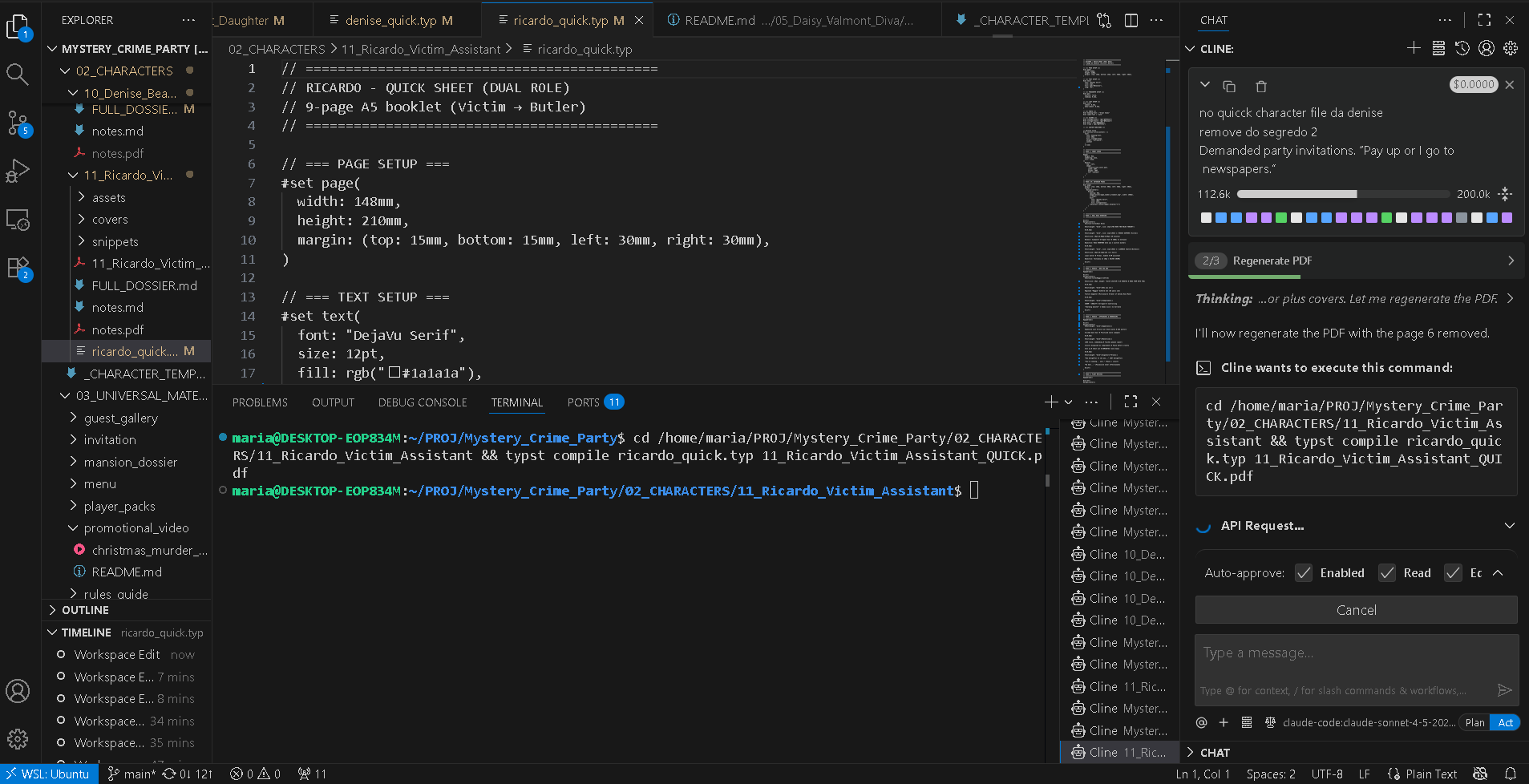
💙 You have my heart.
Cline was the AI coding assistant that made the entire automation pipeline possible. From Python scripts to Git hooks to content assembly—Cline was the development backbone of this project.
Without Cline, none of the automation would have happened.
Design & Assets: Canva Pro
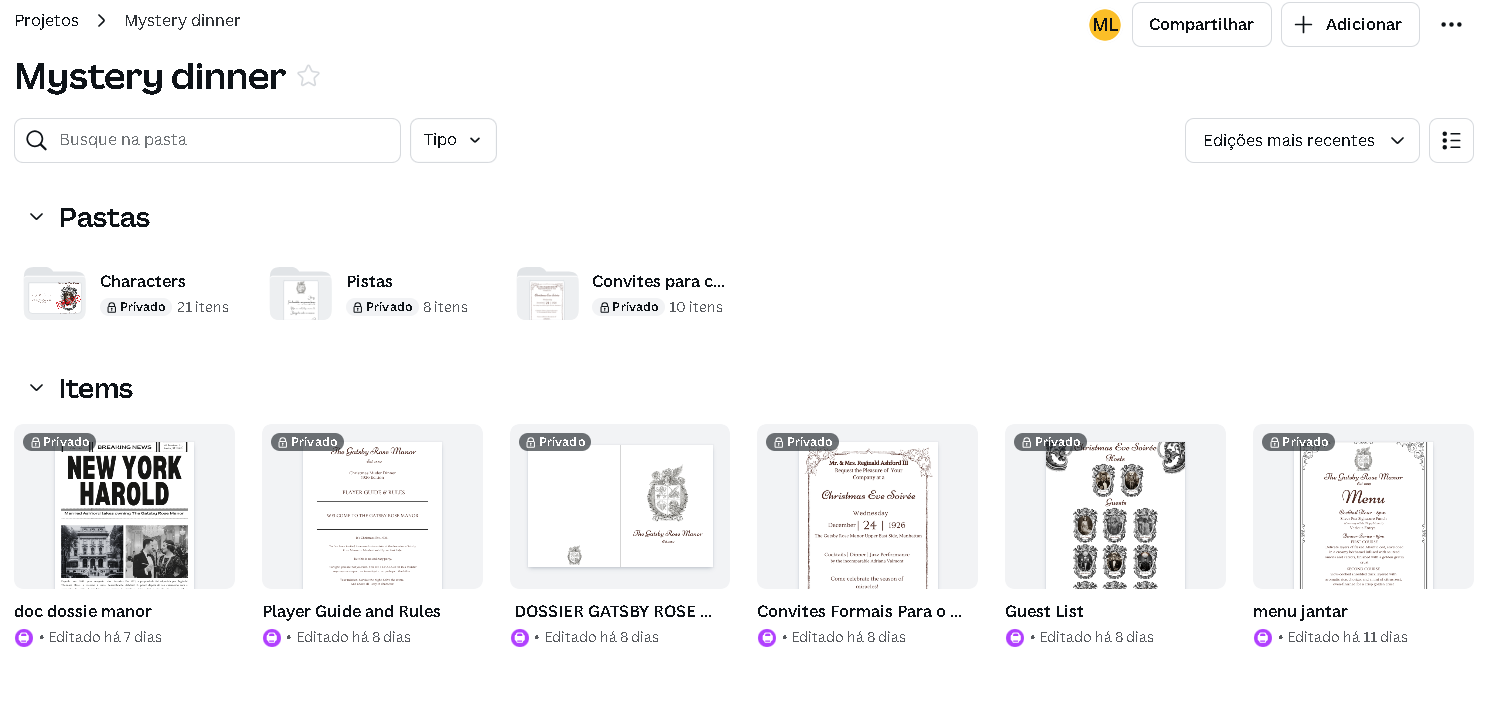
Props & Visual Assets:
- All physical props and visual assets designed in Canva Pro
- Character cards, invitations, promotional materials
- Print-ready designs for game materials
- Quick iterations and professional results
(photo: finished Canva designs - character cards, invitations, props)
Typesetting & Automation
Typst (replaced LaTeX):
- Faster, modern typesetting system
- Automated character sheet generation
- Template-based modular content
- 100+ pages generated from snippets
graph LR
A[Content
Snippets] --> B[Typst
Templates]
B --> C[Build
Script]
C --> D[Final PDFs
100+ pages]
style A fill:#FFE66D
style B fill:#4ECDC4
style C fill:#FF6B6B
style D fill:#95E1D3
Python + Git:
- Build automation scripts
- Git hooks for version control
- Modular content architecture
- Automated assembly pipeline
Behind the Scenes: The Reality
The Privileged Setup
This project was created with access to:
- Premium AI tool subscriptions
- Fal.ai budget for experimentation
- Friends’ accounts for parallel processing
- ADHD-friendly workflow (no forced breaks, continuous iteration)
This is a privileged setup. It matters to document that reality.
Work Distribution:
pie title AI vs Human Work Split
"AI Generation" : 40
"Human Curation" : 25
"Human Refinement" : 20
"Manual Work" : 15
The Work: Hyperfocus Mode Activated
14+ hours per day. Non-stop. Super hyperfocused.
Not bragging—just the reality of ADHD hyperfocus when the right project hits.
When you’re in the zone, you don’t stop. You learn by doing. You iterate constantly. You make mistakes and fix them immediately. You generate more content than you need because you’re exploring every possibility.
This project was built in that state. It’s a privileged position to be able to work like that, but it’s also how the learning happened.
The Creative Chaos
- Tested MANY tools on Fal.ai before finding what worked
- Generated more content than I needed
- Fell in love with video clips I didn’t use
- Learned an insane amount in 2 weeks
- Nobody’s suggestion paid off (he was right, again)
What Worked
✅ Claude as creative collaborator - Feeds creativity, doesn’t replace it
✅ Cline for development - Made automation pipeline possible
✅ lm-arena for video - Better results than standalone tools
✅ Gemini for character images - Prompt + photo = consistent portraits
✅ Adobe Firefly for SFX - Professional audio without a sound designer
✅ Typst over LaTeX - Faster, easier automation
✅ Git for creative projects - Version control for storytelling
✅ Modular content architecture - Easy iterations and updates
mindmap
root((� The Dream Team))
🤖 AI Collaborators
Claude
Creative partner
Feeds creativity
Doesn't replace it
Gemini
Character images
Prompt + photo
Consistent portraits
LM Arena
Video creation
Better than standalone
Multi-model testing
💻 Development Stack
Cline
Automation pipeline
Dev efficiency
Code generation
Typst
Faster than LaTeX
Easy automation
Clean documents
Git
Version control
Creative projects
Collaboration
🎨 Production Tools
Adobe Firefly
Professional SFX
No sound designer
High quality audio
Canva
Visual design
Quick mockups
Brand consistency
Mermaid
Auto diagrams
Documentation
This diagram!
🏗️ Architecture
Modular Content
Easy iterations
Clean updates
Scalable system
Reusable components
What I Learned
“AI can’t be creative” → Wrong. AI can be an incredible creative collaborator.

But it’s not about the AI replacing you. It’s about the AI feeding your ideas, helping them evolve, and handling the production work while you stay in creative control.
Claude was the mastermind. Cline was the builder. I was the director. The game was the result.
graph LR
A[Claude
The Mastermind] --> D[Murder Mystery
Game]
B[Cline
The Builder] --> D
C[Maria
The Director] --> D
style A fill:#9B59B6
style B fill:#3498DB
style C fill:#E74C3C
style D fill:#2ECC71
Bloopers & Failures
The reality of AI-assisted creation: Not everything works the first time. Or the tenth time.
Video Generation Gone Wrong:
The Prompt:
Extreme macro close-up, broken piano wire approximately 30cm length coiled on dark wood surface (mahogany desk), wire diameter 0.8mm visible in sharp detail, dark brownish-red stains on sections of wire (dried blood implication), one end shows clean break with metal fiber separation visible, wire casts dramatic shadow from single key light above left, camera slow rotation orbit 270 degrees around wire over 6 seconds revealing different angles and stain patterns, slight movement as if wire has subtle life (micro-vibration), shot with 100mm macro lens f/2.0, ultra-sharp focus showing steel wire texture, color grading dark noir with cool blue tones, stains appear darker brown, photorealistic metal material and forensic detail, 8K macro, unsettling
What I got: …that weird moving thing. 😂
My reaction:
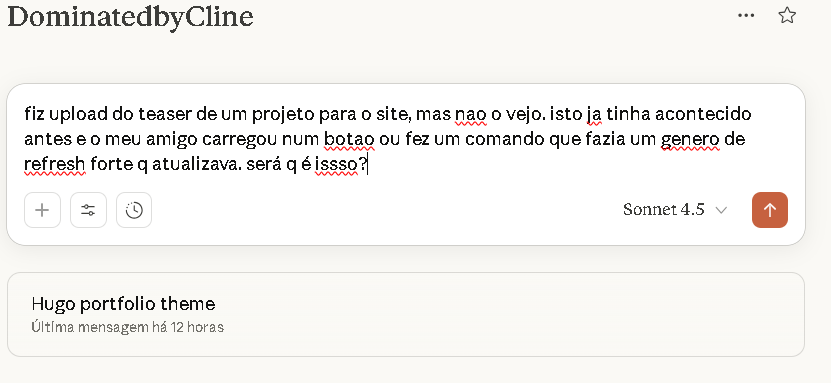
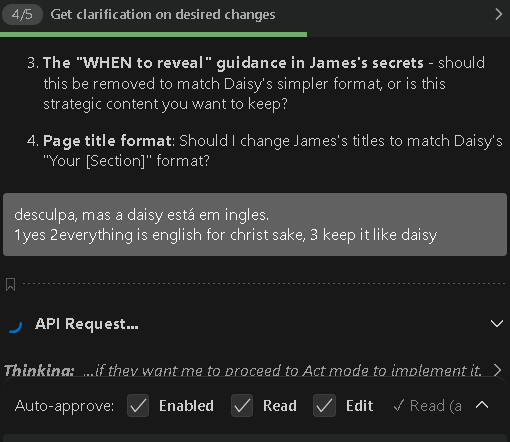
Want more chaos? Read the full Bloopers & Failures post with all the weird outputs, failed generations, and “wtf just happened” moments. 💀
Deep Dive Posts
Published:
- ✅ Why lm-arena Beats Fal.ai (And Standalone Sora)
- ✅ Murder Mystery Bloopers: When AI Gets Creative (In the Wrong Way)
- ✅ Video Production Pipeline: From Concept to Final Cut
- ✅ 11 Characters, One Murder
Coming soon:
- AI-assisted character development workflow
- Automated typesetting with Typst
- Modular content architecture for creative projects
- Git for creative projects (version control for storytelling)
Want updates? Follow #artifactum
The Final Sprint
Current status: Finishing the final details. Almost ready for December 25.
Project Timeline:
gantt
title Murder Mystery 1926 - Development
dateFormat YYYY-MM-DD
section Week 1
Character Design :done, a1, 2025-09-30, 7d
Story Architecture :done, a2, 2025-10-02, 5d
section Week 2
AI Asset Generation :done, a3, 2025-10-07, 4d
Video Production :done, a4, 2025-10-09, 3d
Typesetting Setup :done, a5, 2025-10-11, 2d
section Final Sprint
Final Assembly :active, a6, 2025-10-13, 2d
Testing & Polish :a7, 2025-10-15, 10d
Event Day :milestone, a8, 2025-12-25, 0d
Feelings: Exhausted. Proud. Nervous. Excited.
Note: Full game details and character materials available upon request. The game will be played December 25, 2025. Almost there! 🎭🎄
Comments